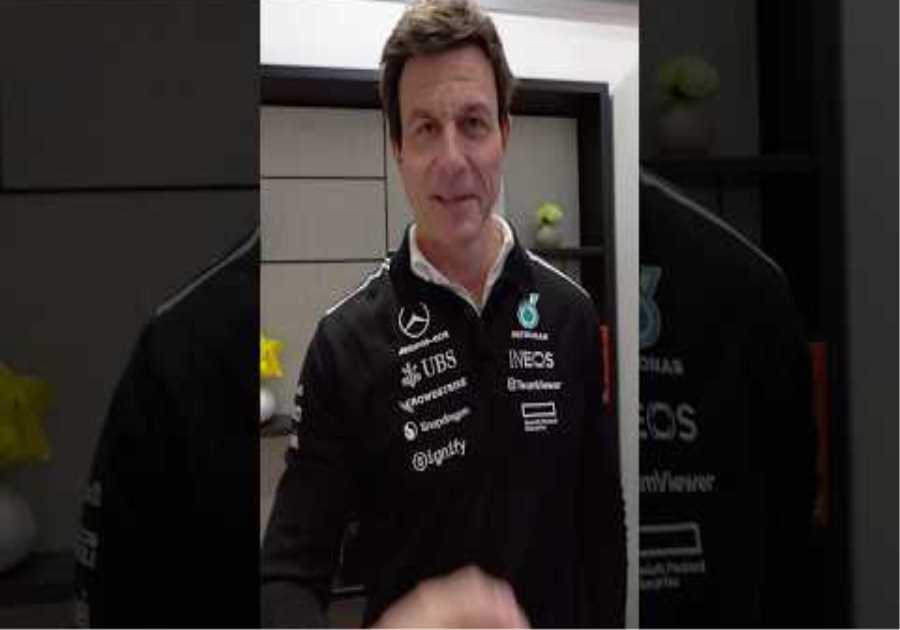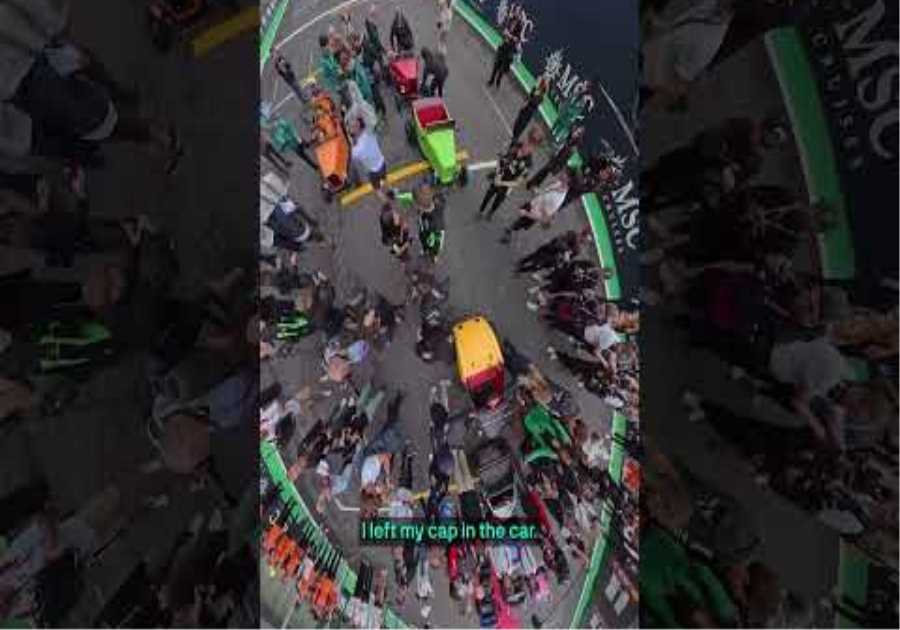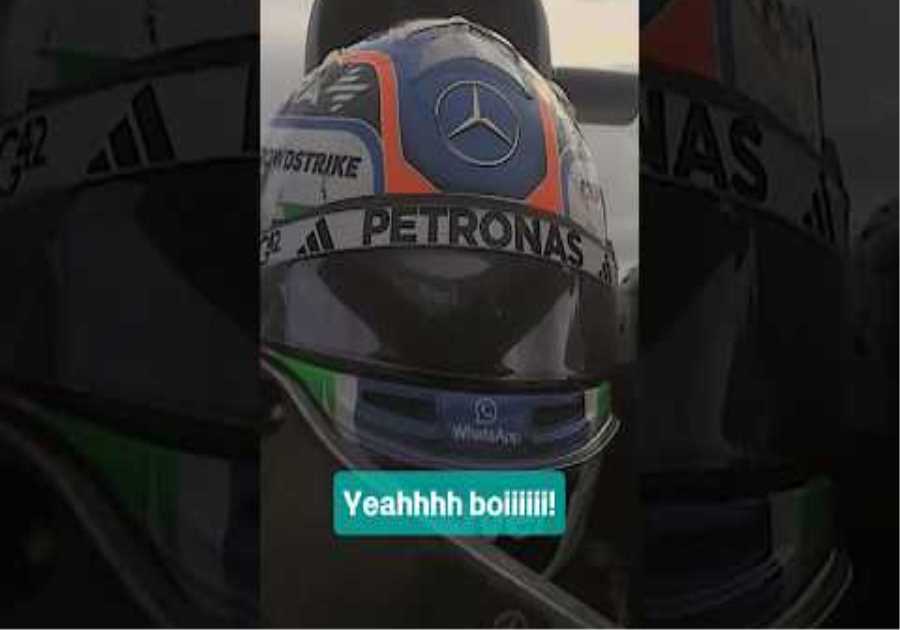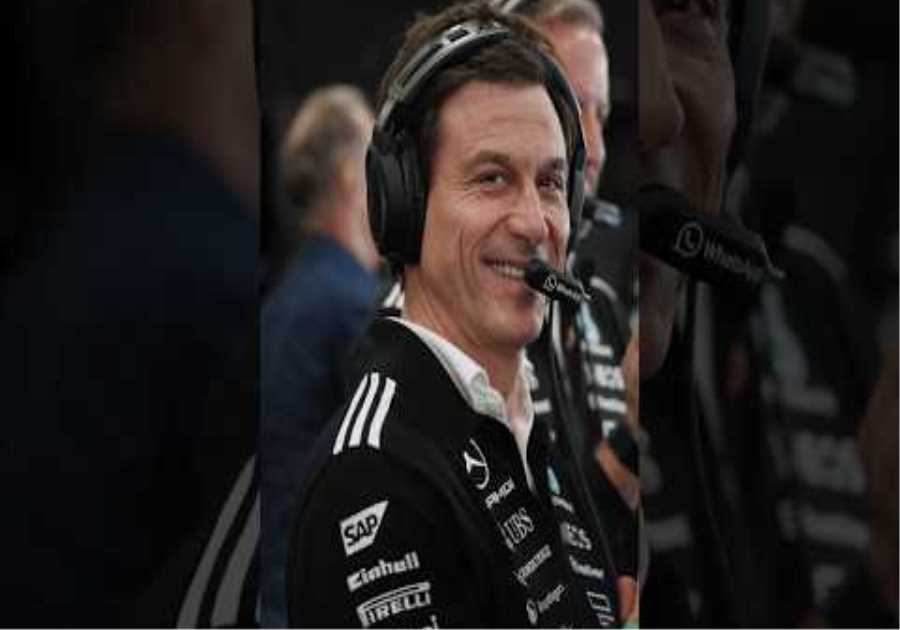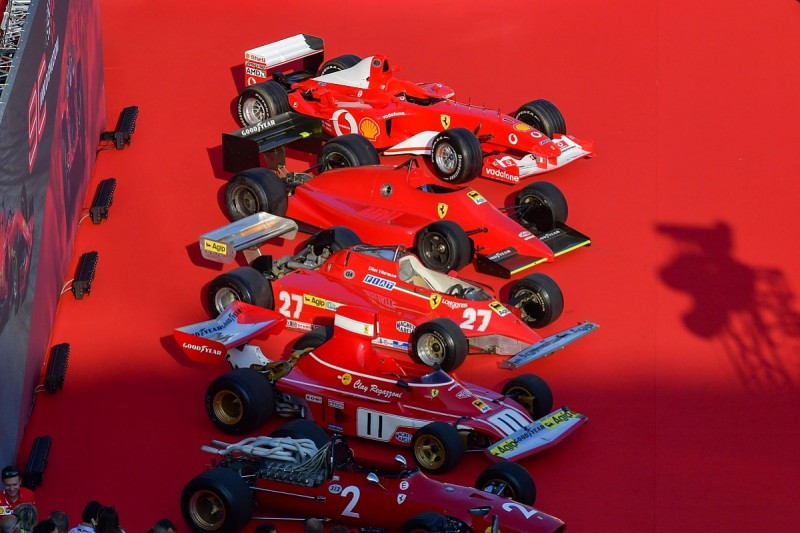
Ferrari will celebrate starting its 1000th world championship race at this weekend’s Tuscan Grand Prix at Mugello.
From its 999 outings so far Ferrari has scored 238 grands prix wins, 15 drivers’ titles and 16 constructors’ crowns. That means that Formula 1’s most famous team has produced a lot of candidates for this list.
To create this top 10 we considered a number of factors, including the level of success each car scored, how important it was for Ferrari, and how iconic they are.
And for those with long memories, yes, we know that the Ferrari 500 was an F2 car, but its 1952-53 starts are included in the 1000, so the car is eligible for our list.
Note: Wins are world championship grand prix wins, non-championship successes are not included.
10. Ferrari 375
Wins: 3
Drivers’ titles: 0
Constructors’ titles: 0
This spot had to go to the 375, which scored Ferrari’s first world championship GP victory, or the 641, one of the best-looking F1 cars of all time.
Both narrowly missed out on titles and both won major GPs in the hands of two of the best drivers of their era. But whereas the 641 failed to achieve what it was designed to do – win a world title – the 375 is the car that made Ferrari a world championship F1 race victor.
Alfa Romeo’s 158, a successful voiturette (very roughly equivalent to Formula 2) before the Second World War, had been the grand prix car to beat following the end of hostilities.
Autosport 70: Remembering Formula 1’s first great racing machine
Alfa skipped the 1949 season, during which Ferrari proved successful, but when Alfa returned in 1950 it was still clear of the pack – and hadn’t been beaten since 1946. But it had been noted that the increasingly developed 1.5-litre supercharged straight-eight engine was incredibly thirsty, with multiple stops being required to complete a race distance.
Big, unblown Talbot-Lagos had proved reasonably effective and Enzo Ferrari decided to try the unsupercharged route. Aurelio Lampredi was brought in to develop a series of bigger-engined Ferraris and the 4.5-litre 375 first appeared at the 1950 Italian GP, the final round of the season. Alberto Ascari and Dorino Serafini finished second, albeit over a minute behind the winning Alfa.
Having scored several more podiums in 1951, the 375 finally defeated the Alfa Romeo team on a historic day at Silverstone, Jose Froilan Gonzalez winning the British GP. It was Ascari who tended to lead the charge, however, and two wins brought him within two points of Alfa’s Juan Manuel Fangio heading into the Spanish GP finale.
Ascari qualified on pole and led early on, but Ferrari’s decision to change the specification of its wheels proved catastrophic. The smaller rubber could not stand the strain and Fangio was left to win the race and title.
Alfa withdrew at the end of the season and, with BRM’s F1 project still failing, the decision was made to switch the world championship to F2 regulations for 1952. That meant the end of the 375’s career outside of non-points-paying events, but it had very much made its mark.
9. Ferrari 126C2/126C2B

Wins: 5
Drivers’ titles: 0
Constructors’ titles: 2 (1982-83)
Renault led the way with turbocharged engines at the end of the 1970s, but failed to capitalise and Ferrari was the first constructor to take an F1 title with a turbo. That came courtesy of Harvey Postlethwaite’s 126C2, which won the constructors’ championship in 1982.
Aside from the ill-starred 1973 312B3, the 126C2 was Ferrari’s first full monocoque F1 chassis and the first to successfully utilise ground-effects. Renault’s RE30B and the Brabham-BMW BT50 were often faster, but lacked the Ferrari’s reliability.
The car was certainly not Ferrari’s luckiest. Gilles Villeneuve was killed in a terrible qualifying crash at the Belgian GP, while Osella driver Riccardo Paletti died when he struck the back of Didier Pironi’s stalled Ferrari at the start of the Canadian GP. But a string of podium finishes had taken Pironi into a nine-point lead when he arrived at Hockenheim for the German GP, round 12 of 16.
Sadly, in appalling conditions in practice, he hit Alain Prost’s Renault and the Ferrari cartwheeled to destruction, ending Pironi’s career. Patrick Tambay won the race and Ferrari ultimately beat McLaren by five points in the constructors’ contest, but Pironi’s tally was overhauled by Williams driver Keke Rosberg.
Flat bottoms were mandated for 1983 to cut the amount of downforce created by ground-effects, and the revised 126C2B was still good enough to win two more races before being replaced by the 126C3. Interestingly, Tambay had been right in the title fight before the switch, but a run of non-finishes in the closing stages of the campaign meant he fell to fourth, behind team-mate Rene Arnoux.
The points total scored by the 126C2B and 126C3 was, however, enough for Ferrari to retain its constructors’ crown. It would be 16 years before it won another.
8. Ferrari 246 Dino

Wins: 5
Drivers’ titles: 1 (Mike Hawthorn, 1958)
Constructors’ titles: 0
Ferrari had just experienced its first winless season in the world championship in 1957 (excluding its part-campaign in 1950) when the Vittoria Jano/Carlo Chiti 246 arrived. Other than Ferrari’s first use of a V6 engine in F1, the Dino broke little new ground, but it was a sound design.
Chief rival Vanwall had marginally the faster car over the balance of the season and took the inaugural constructors’ title, but the Ferrari was arguably an easier car to drive and was reliable for the time. That helped Mike Hawthorn take five second places and five fastest laps, to go with his win in the French GP, enough to pip Vanwall’s Stirling Moss (with four wins) to the drivers’ crown by a single point.
The rear-engined revolution was well under way in 1959, but the front-engined Ferrari was still in the mix, at least on fast circuits. Tony Brooks won at Reims and Avus and went to the season finale with a chance of the title, against Cooper drivers Moss and Jack Brabham.
That didn’t go his way and Ferrari was outclassed in 1960, its only victory coming in the Italian GP when the British teams boycotted the event due to the use of the banking at Monza. The Dino nevertheless has its place as the last front-engined car to win the drivers’ crown and a world championship GP.
7. Ferrari 500

Wins: 14
Drivers’ titles: 2 (Alberto Ascari, 1952-53)
Constructors’ titles: 0 (not inaugurated until 1958)
In the absence of serious opposition to Ferrari in F1, the world championship was run to two-litre unsupercharged F2 regulations in 1952-53, but Ferrari dominated anyway. Excluding the anomalous Indianapolis 500, which counted for points between 1950 and 1960, Aurelio Lampredi’s four-cylinder racer took every pole and victory in 1952, with Ascari waltzing to the crown by winning six of the eight rounds.
RETRO: The rise and fall of F1’s first great champion
Maserati put up more of a fight the following year, with Fangio taking two poles, but Ferrari was still set to win every championship GP until a dramatic final lap at the season-closing Italian GP allowed Fangio to slip through to victory. Ascari nevertheless took his second world crown, though Ferrari didn’t win the constructors’ title because there wasn’t one until 1958.
The F2 era was not the most competitive period in the world championship, but there is no doubt that Ferrari was the dominant force – and the 500 racked up numbers that would take many years to be overcome.
PLUS: When was Formula 1 closest?
6. Ferrari F2007

Wins: 9
Drivers’ titles: 1 (Kimi Raikkonen, 2007)
Constructors’ titles: 1 (2007)
The fight for the youngest car on this list was between the F2007 and its successor, the F2008. The later car was, on raw pace, marginally quicker compared to its rivals, but results matter and it was the F2007 that just delivered Ferrari a title double – its last at the time of writing in 2020.
Kimi Raikkonen switched to Ferrari for 2007 and sensationally won on his – and the F2007’s – debut with the team at the Australian GP opener. The fight with McLaren was intense, heightened by the spy scandal, and the advantage swung back and forth between the two teams.
Despite being 17 points behind with two races to go (when a win scored just 10), Raikkonen came through to defeat McLaren duo Lewis Hamilton and Fernando Alonso by a single point.
The F2007’s final tally was nine wins and nine poles from 17 races, compared to the McLaren MP4-22’s scores of eight and eight, after one of F1’s closest seasons.
5. Ferrari 156 ‘Sharknose’

Wins: 5
Drivers’ titles: 1 (Phil Hill, 1961)
Constructors’ titles: 1 (1961)
In terms of raw pace, the 1961 156 ‘Sharknose’ is the third-most dominant Ferrari in world championship history, behind only the 1952 500 and 1956 D50 (which was really a Lancia and therefore doesn’t make this list). The nostril grill that gives it its name also make the Carlo Chiti design one of Ferrari’s most iconic.
Ferrari was well prepared for the switch from 2.5-litre to 1.5-litre F1 engines in 1961. While the British teams moaned and even attempted to set up their own rival series, Ferrari and Porsche had honed their designs in F2.
PLUS: When a breakaway series tried and failed to usurp F1
The then unknown Giancarlo Baghetti had already won the non-championship Syracuse GP when three 156s arrived at the season-opening Monaco GP. There, they were defeated by a driver of virtuosity by Moss in Rob Walker’s privateer Lotus, but a 1-2 next time out at Zandvoort was a better indicator of how the season would unfold.
PLUS: Sir Stirling Moss’ 10 greatest drives
Power was the 156’s trump card and at the high-speed Spa, Phil Hill led a 1-2-3-4, the fastest non-Ferrari qualifying 6.7 seconds off Hill’s pole time.
Baghetti took a slightly fortunate win in the French GP with the older 65-degree V6 as quicker Ferraris with 120-degree versions failed, before Wolfgang von Trips led a 1-2-3 at the British GP.
Another great Moss drive at the Nurburgring restricted Ferrari to 2-3, but the fight for the drivers’ crown was between von Trips and Hill. That was decided in tragic circumstances when von Trips and 15 spectators were killed in a crash on lap two and Hill went on to win. With both titles clinched, Ferrari skipped the season finale at Watkins Glen.
By the following season, the leading British teams – chiefly Lotus and BRM – had better V8 power and finer chassis than Ferrari. The 156 scored three podiums at the start of the season, but Ferrari had been overtaken and suffered amid internal turmoil that left it sixth in the constructors’ table.
All the ‘Sharknose’ racers were broken up, but their place in Ferrari – and F1 – history remains.
4. Ferrari F1-2000

Wins: 10
Drivers’ titles: 1 (Michael Schumacher, 2000)
Constructors’ titles: 1 (2000)
There are better cars on this list and cooler ones that aren’t, but the F1-2000 has a significant place in Ferrari folklore as the machine that finally ended the longest wait. Ferrari hadn’t won the F1 drivers’ crown since Jody Scheckter and, even though it had won the constructors’ title with the F399 in 1999, the focus was on Michael Schumacher finally adding to the two championships he had won with Benetton.
Things started well with a 1-2 in the Melbourne opener, even though that result was helped by engine problems for McLaren, which had locked out the front row. McLaren had more problems at Interlagos before Schumacher made it three wins in a row by beating both Mika Hakkinen and David Coulthard at Imola.
PLUS: The car that restored Ferrari’s respectability
McLaren mounted a comeback and victory for Hakkinen in the Hungarian GP moved the Finn to the top of the points table. A brilliant win in Belgium extended the gap before Schumacher won in Italy and the US.
That meant he arrived at the penultimate round in Japan with an eight-point lead and, after a flat-out duel with Hakkinen, took victory to put the drivers’ title beyond reach and end Ferrari’s long wait.
The F1-2000’s 10th win in the Malaysian GP finale was more than enough to secure Ferrari the constructors’ crown.
3. Ferrari F2002

Wins: 15
Drivers’ titles: 1 (Michael Schumacher, 2002)
Constructors’ titles: 1 (2002)
Schumacher’s title successes of 2000 and 2001 established Ferrari as the team to beat in the early years of the millennium, but the 2002 season moved things on to another level.
The F2002, the work of the same Ross Brawn-led team that had already taken three constructors’ and two drivers’ titles, made its debut in the 2002 Brazilian GP, round three of the season. Schumacher took a narrow victory over brother Ralf in a Williams, but thereafter the F2002 was more dominant.
It was beatable in qualifying, scoring ‘only’ eight poles, but Sundays were a different matter. The F2002 took 14 wins from its 15 races in 2002 – its only defeat coming thanks to one of David Coulthard’s greatest races at Monaco – and Ferrari scored as many points as the other 10 teams combined.
PLUS: David Coulthard’s top 10 greatest drives
If there is a negative associated with the F2002 it is that it was the car involved in the controversial Austrian GP team orders scandal and the farcical scenes of the ‘photo finish’ between Rubens Barrichello and Schumacher at the US GP. But you could also argue it was the car’s sheer supremacy that allowed Ferrari to play such games in the first place.
Just as the F2001 – another candidate for this list – had done extra service at the beginning of 2002 (and won once), the ‘B’ version of the F2002 contested the first four rounds of 2003, Schumacher winning the San Marino GP to take the car’s final tally to 15, and its pole score to 11.
2. Ferrari 312T/312T2

Wins: 17
Drivers’ titles: 2 (Niki Lauda, 1975 and 1977)
Constructors’ titles: 3 (1975-77)
We’ve counted the 312T and 312T2 together because they were very similar, with some minor changes, such as to the air intakes, brought in due to rule tweaks.
The 1974 312B3 had come close to ending Ferrari’s wait for a title – which stretched back to 1964 – but bad luck and unreliability had cost it. Mauro Forghieri’s 312T moved things up a notch in 1975, with the transverse-mounted gearbox aiding chassis balance.
The flat-12 engine produced more than 500bhp reliably and Niki Lauda dominated the campaign. Nine poles and five wins from 14 races comfortably gave the Austrian the crown, while Clay Regazzoni won the Italian GP and Ferrari also took the constructors’ title.
The 312T took three more wins at the start of 1976 before the 312T2 arrived. Lauda would almost certainly have won the crown again had it not been for the German GP crash that left him near death, but Ferrari still finished the season with six wins and another constructors’ championship success.
By 1977 the 312T2, now in revised ‘B’ spec, was no longer the quickest car – Ferrari was only fourth fastest on raw pace – but a combination of reliability and Lauda brought another title double. Carlos Reutemann added another victory at the start of 1978 in Brazil before the introduction of the 312T3, which had a new monocoque and fresh suspension so isn’t counted in the statistics above.
The 1979 312T4 deserves an honourable mention too, its reliability and consistency helping Scheckter and Villeneuve to a 1-2 in 1979, the last time a Ferrari driver would win the crown until the arrival of Schumacher.
1. Ferrari F2004

Wins: 15
Drivers titles: 1 (Michael Schumacher, 2004)
Constructors’ titles: 1
It doesn’t have the longevity of the 312T series, but that’s more due to the changing nature of F1 than anything else. The F2004 was the culmination of the remarkable Ross Brawn/Rory Byrne/Michael Schumacher Ferrari era.
The V10-engined machine was so fast in pre-season testing that the team thought it had made an error and, thanks to subsequent rule changes, it has taken until the last two or three years for many of the F2004’s myriad lap records to fall.
PLUS: The car so good it shocked Ferrari
Ferrari’s almost symbiotic relationship with tyre supplier Bridgestone paid dividends and the car was very reliable – its only retirements in 2004 came due to clashes. The F2004 ‘only’ scored 12 poles, partly due to the qualifying format of the era and partly due to the nature of the Bridgestones, but was invariably leagues quicker than the opposition in the races.
As well as the 15 wins from 18 2004 races, Ferrari scored eight 1-2s, while Schumacher and Rubens Barrichello finished well clear of third-placed Jenson Button in the drivers’ table.
PLUS: The best cars never to win a grand prix
Ferrari’s domination led to rule changes for 2005, which did help to end Schumacher’s run, but the modified F2004M was still good enough to finish on the podium in the Australian GP season opener.
The F2004 is not only the greatest F1 Ferrari, it was a leading contender when Autosport debated what the greatest grand prix car is in one of our Autosport 70 podcasts.



